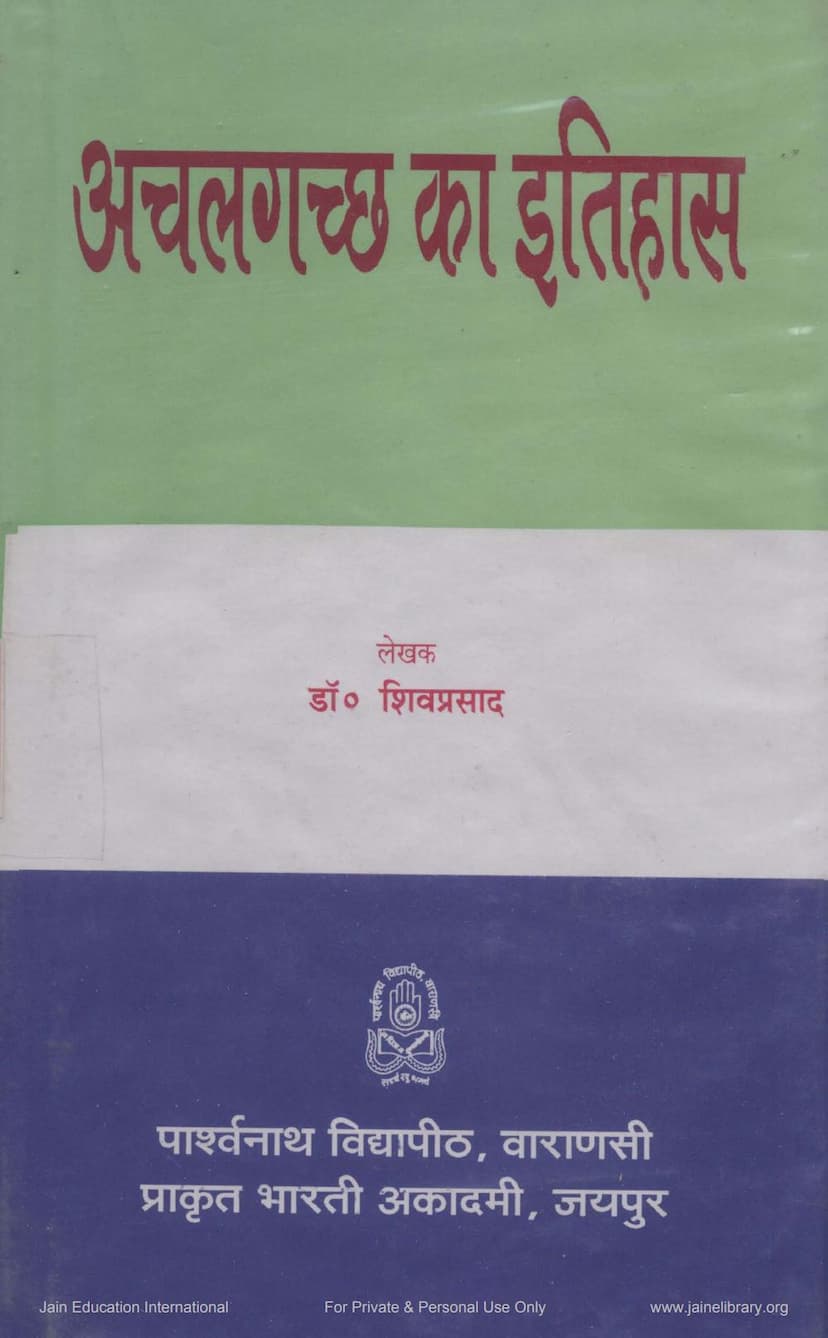Achalgaccha Ka Itihas
Added to library: September 1, 2025

Summary
Here's a comprehensive summary of the Jain text "Achalgaccha ka Itihas" (History of the Achalgaccha) by Shivprasad, based on the provided pages:
Book Title: Achalgaccha ka Itihas (अचलगच्छ का इतिहास) Author: Dr. Shivprasad Publisher: Parshwanath Vidyapith, Varanasi & Prakrit Bharti Academy, Jaipur Year of Publication: 2001
Overview:
This book, "Achalgaccha ka Itihas," authored by Dr. Shivprasad and published in 2001, provides a detailed historical account of the Achalgaccha (formerly known as Achalgacch or Vidhipaksh), a significant sect within the Shvetambara Murtipujaka community of Jainism. The text highlights the establishment, evolution, key figures, and contributions of this Gaccha, tracing its journey from its inception to the present day.
Establishment of the Achalgaccha:
- The Achalgaccha was founded in 1169 VS (1113 CE) by Acharya Aryarakshitsuri, a disciple of Acharya Jayanandisuri of the Brihadgaccha.
- The Gaccha came into existence due to the establishment and adherence to the "Vidhimarga" (path of prescribed rituals and conduct).
Origin of the Names "Achalgaccha" and "Anchalagaccha":
The text discusses two popular legends behind the naming of the Gaccha:
-
Achalgaccha: According to one legend, King Jayasimha Siddharaja of Gujarat, while performing a son-fulfillment sacrifice (Putrakameshti Yagna), faced a crisis when a cow died due to snakebite within the sacrificial arena. As the success of the Yagna depended on the cow's revival, he sought the help of Aryarakshitsuri. The Acharya, using his knowledge of "Parakaya Praveshini Vidya" (the science of entering another's body), revived the cow, which then exited the arena alive, thus ensuring the Yagna's success. For his unwavering adherence to his word ("achal"), Siddharaja bestowed upon him the title "Achal." This event is believed to have occurred between 1185-95 VS. This legend connects the name "Achalgaccha" to Aryarakshitsuri's steadfastness.
-
Anchalagaccha: Another legend attributes the name "Anchalagaccha" to King Kumarpal of the Chalukya dynasty. Upon hearing of Aryarakshitsuri's fame, Kumarpal invited him to his court. There, a layman named Kudivyavahari greeted Aryarakshitsuri by touching his feet with one end (anchal) of his upper garment (uttariya), thus purifying the ground before offering reverence. When Kumarpal inquired about this ritual, Acharya Hemchandrasuri confirmed it as scripturally sanctioned. Kumarpal, impressed by this practice of using the garment's end (anchal), named the Vidhipaksh as "Anchalagaccha." This event is dated to 1213 VS (1157 CE).
Historical Authenticity of the Names:
The author suggests that the second incident, related to Kumarpal, is closer to historical truth, as ancient inscriptions, stone and metal plates (pratimalekhas), and historical records predominantly confirm the name "Anchalagaccha" rather than "Achalgaccha." The name "Achalgaccha" appears to have emerged later. Currently, followers of this Gaccha use the term "Achalgaccha."
Prominent Acharyas of the Gaccha:
The Achalgaccha has been graced by numerous influential and scholarly Acharyas throughout its history, including:
- Aryarakshitsuri (Founder)
- Jayasinhsuri
- Dharmaghoshsuri
- Mahendrasinhsuri
- Dharmaprabhasuri
- Mahendraprabhasuri
- Jayasekharsuri
- Merutungasuri
- Jayakesarisuri
- Dharmamurthisuri
- Kalyansagarsuri
- Amarsagarsuri
- Vidyasagarsuri
- Udaysagarsuri
- Kirtisagarsuri
- Punyasaagarsuri
- RajendraSagarsuri
- Mukthisagarsuri
- Ratnasagarsuri
- Viveksagarsuri
- Jinendrasagarsuri (Last "Shripujya" or Yati leader)
- Gautamasagarsuri (Revived the "Samvegi" path and became the first Acharya of the new era)
- Gunasagarsuri (Continued the revival and growth)
- Gunodayasagarsuri (Current Gaccha-adhipati)
- Kalaprabhasagar (Current Acharya and significant scholar)
Challenges and Revival:
Over time, laxity ("shithilachar") entered the Gaccha. In the 20th century VS (19th Century CE), Munishri Gautamasagari actively opposed this laxity and re-established the "Suvihitmarga" (path of strict adherence to scriptures). After the demise of the last "Shripujya" Acharya Jinendrasagarsuri in 2004 VS, the Yati-Gorji tradition ended. Munishri Gautamasagari, a "Samvegi" muni, revitalized the Gaccha, and in 2008 VS, he was enthroned as the Acharya and Gaccha-nayak. Under his leadership and that of his successors, the Gaccha experienced significant growth, with many individuals taking monastic vows.
Branches of the Achalgaccha:
Over time, various branches emerged from the Achalgaccha due to different reasons. Prominent among these were:
- Kirtishakha
- Gaurakshashakha
- Chandrashakha
- Palitanashakha
- Labhashakha
- Sagarakha
The book details the history and individuals associated with these branches. Currently, no independent branches of the Achalgaccha exist.
Literary Contributions:
The Achalgaccha has made substantial contributions to Jain literature, with its monks and scholars authoring numerous works in Prakrit, Sanskrit, Apabhramsha, Maru-Gurjar, and other languages. These works cover various subjects, including philosophy, theology, history, grammar, poetry, and rituals. The book extensively lists the works of many Acharyas and Munis, providing details of their compositions and often their lineage. The author relies heavily on inscriptions, prashastis (eulogies in texts), and pattavalis (genealogical records of preceptors) as primary sources for this historical reconstruction.
Sources and Methodology:
Dr. Shivprasad emphasizes the importance of both literary and archaeological evidence for studying the history of monastic orders. He highlights the significance of granthaprashtis (colophons of manuscripts) and pattavalis for understanding the guru-parampara and the activities of Acharyas. He also extensively utilizes epigraphic evidence, such as inscriptions on temple walls and statues, as crucial historical data. The book lists various published catalogs of Jain manuscripts and collections of inscriptions, indicating a thorough research approach.
Current Status of the Gaccha:
The Achalgaccha remains a vibrant and influential sect within Jainism, particularly in Gujarat, Rajasthan, and parts of Maharashtra. The book notes that despite the relatively smaller number of monks and nuns compared to some other sects, the Gaccha holds significant influence due to the support of a prosperous community, especially the Kacchi community. The present leadership, under Acharya Gunodayasagarsuri and Acharya Kalaprabhasagar, continues to guide the Gaccha's development and promote Jain teachings.
Overall Contribution:
"Achalgaccha ka Itihas" is a scholarly work that fills a significant gap in the historical literature available in Hindi on the Achalgaccha. It meticulously compiles information from a wide range of sources, presenting a well-researched and detailed history of this important Jain lineage, making it an invaluable resource for scholars and followers interested in Jain history and tradition. The comprehensive lists of Acharyas, their works, and the detailed analysis of inscriptions and pattavalis are particular strengths of this book.